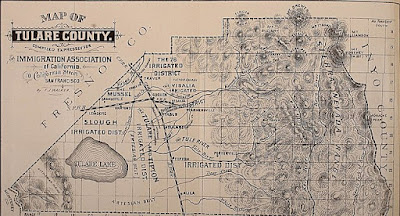When I began research on my Mail-Order Mama book about two years ago, I decided to set the story in Sonora, California, where I recently had visited to do some research. One of the elements of this series was that the characters were to arrive at their destination by stagecoach. Even though I set my story in 1885, after railroad tracks reached many localities—including in California—stagecoach travel to Sonora was no issue. The train did not arrive there until 1899.
I found a great map that showed stagecoach routes throughout California from the 1850s to 1860s. Still helpful, since many stagecoach routes in the foothills and mountains still existed in later years. However, what really drew my attention was the big blue lake at the south end of San Joaquin Valley. I have lived in San Joaquin Valley for over fifty years, and I knew of no lake in that location. Curiosity piqued, I began my research.
That big blue dot was Tulare Lake, the largest lake by surface dimension west of the Mississippi River—larger than the Great Salt Lake or Lake Tahoe. It was the second-largest freshwater lake entirely in the United States based upon surface area.
Tulare Lake was at one time part of Lake Corcoran, which covered the Central Valley of California. 600,000 years ago. Although it is not known how, a new outlet formed in the present-day San Francisco Bay, which rapidly carving an outlet through Carquinez Strait. This drained the lake, leaving the Buena Vista Lake, Kern Lake, and Tulare Lakes as remnants.
 |
| 1772 Southern San Joaquin Valley showing Tulare Lake |
In 1773, Commandant Tagus, an Emissary for the Spanish Governor and the first white man to view the lake, named it "Los Tules." In 1825, the lake became public knowledge when the legendary Jedediah Smith led the first band of white settlers into the San Joaquin Valley.
It was also called La Laguna de los Tulares by Spanish explorers, and covered more than 1,200 square miles. The Spanish word tulare refers to a field of tule rush, which aptly described the lake. This section of the southern San Joaquin Valley was the lowest in elevation. It was also the terminus of the Tule, Kaweah, Kings and Kern rivers.
Each spring, the area was transformed into a marsh full of tule elk and antelope, honkers, gray, and Canadian geese. Yokut hunters fished for salmon, perch and sturgeon using rafts and canoes made from the thick tule reeds. The women waded far into the water to dig for clams and mussels.
 |
| Riverboat Alta stranded on Tulare Lake |
The lake was so bountiful that white settlers named the area Mussel Slough. In the 1870s, commercial fishermen went on the lake in schooners and steamboats to catch terrapin turtles, which were served as delicacies in San Francisco restaurants.
 |
| Shows early irrigation plans |
Canals built to serve more and more agriculture affected the flow of the rivers so that Tulare Lake gradually grew smaller and, at times, dried up. Water was also diverted for municipal use. As the lakebed dried up, it was converted to agricultural uses. Canals and dams were built in an effort to keep it that way.
 |
| 1854 California map by John C. Fremont shows Tulare Lake |
However, in years of heavy rainfall, and heavy snowfall in the Sierra Nevada Mountains to the east, the lake reappears. In spite of multiple dams and reservoirs in the mountains and foothills, and diversion canals to funnel the water away from developed farmland, Tulare Lake reappears. 2023 has been one of those years. The Boswell Company, the biggest farming operation in the world, lost thousands of acres of crops to this year’s flood. I recall news reports a couple of months ago telling of dairy farmers moving 7,000 head of cattle within two days to save them from the flood. Even last night’s news—months after the worst of the flooding—featured houses sitting in the middle of the lake with water about four feet up the front doors and windows. Tulare County has allocated money to buy their own air boat instead of relying on those loaned by Pacific Gas and Electric, the local utility.
 |
| Tulare Lake Expedition before 1880 |
In the past, when there has been extensive flooding to the point Tulare Lake reemerged, it took a year or more—in some cases, close to two years—for the lake water to recede so the farmland could be reclaimed. This is one of those years.
Tulare Lake – it’s b-a-a- ck!
In September, I will be publishing a new book set in Sonora, California, titled A Watchman for Willow. It is part of the Mail Order Papa series, and will be a companion book to my Mail-Order Mama book, A Lawyer for Linton.
To find the book description and purchase options for A Lawyer for Linton, please CLICK HERE
A Watchman for Willow is currently on pre-order. To find the book description and pre-order purchase link, please CLICK HERE
Sources:
https://www.tularehistoricalmuseum.org/post/tulare-lake
https://en.wikipedia.org/wiki/Tulare_Lake#
https://www.latimes.com/archives/la-xpm-1997-02-13-mn-28291-story.html





%20in%20height%20covered%20the%20Tulare%20Lake%20archipelago..jpg)


No comments:
Post a Comment